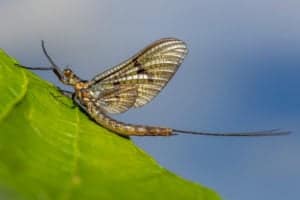A mayfly, sometimes known as the shadfly, is a kind of aquatic bug that is a species of aquatic insect in the order Ephemeroptera. They are most recognized for their exceedingly short lifetime with dragonflies and damselflies being their closest relatives. This is why they are given the scientific term ‘Ephemeroptera,’ which is taken from a Greek word that means short-lived.’
Mayflies are found in about 2.500 different species all over the world. They are a kind of bug that first evolved on Earth 350 million years ago – that is way before the dinosaurs ever roamed the earth. Mayflies vary in size and color depending on the species, making them visually appealing as well as appealing to a variety of predators.
Curious to find out more about these flying aquatic insects? Want to know more about what mayflies eat? We’ll cover all of that and more in this article!
What Do Mayflies Eat?

An adult mayflies’ sole job is to reproduce and die. They do not eat and have only vestigial mouthparts, while their digestive tracts are filled with air. Interestingly, they only ever eat as babies. The babies are predominantly herbivores.
The Mayfly develops in three stages: egg, naiad (larva), and adult. Baby mayflies are known as nymphs.
Females normally lay between 400 and 3000 eggs each year. The eggs are frequently placed onto the water’s surface, where they settle to the bottom. Nymphs often eat algae or water plants. When nymphs dig at the lake’s bottom, their respiratory gills enlarge, and this action transports food through the tunnel. Mayfly nymphs crawl across stones and weeds to feed on bacteria for their own sustenance. They may feed on debris or accumulate from sediments.
As they progress to the next stage of being a subimago, they lose the ability to eat because they no longer have a mouth.
They do not stay in this stage for long since they become full adults within a day. An adult mayfly’s primary goal is to survive until the next day when they will be able to mate and then die because they do not ingest food.
What Predators Eat Mayflies in the Wild?
Mayflies play a critical role in the aquatic food chain. Snails and caddisfly larvae consume mayfly eggs. Fish, frogs, birds, flies, and water beetles may consume the nymphs. Fish, birds, dragonflies, water beetles, and other predatory insects consume subimagos. Mayflies at their subimago stage are a favorite diet of many fish, and many fishing flies are designed to look like them. Mayflies as adults are an essential food source for trout, bass, catfish, frogs, newts, and birds.
The level of predation on mayflies varies depending on the season, the size of the nymphs, and the behavioral patterns at the time. Mayfly nymphs, for example, are particularly susceptible as they emerge.
How Does Their Diet Impact Other Species

Only clean water settings may support mayflies. They cannot survive in polluted environments.
©Achkin/Shutterstock.com
Now that we know what mayflies eat, let’s explore their impact on the environment.
Mayfly nymphs play a crucial role in a variety of freshwater habitats. Mayfly grazing is vital for preventing the accumulation of a large biomass of aquatic algae and detritus, as well as for nitrogen cycling. Because mayflies may be plentiful in different settings, they are a significant food source for many predator species.
Studies have shown that mayflies not only transport nutrients within aquatic ecosystems but also between them. This might be critical for the survival of a range of aquatic ecosystems, especially if various climatic projections come true.
Mayfly species are also quite picky about where they live and how they tolerate environmental factors like water temperature and the composition of water. Because of their unique ecological requirements, aquatic ecologists frequently use these species as indicators of water quality. So if you happen to see a lot of mayflies around a body of water, that is actually a great indication that the water quality is great.
Parasites such as nematodes and trematodes may also use mayfly nymphs as hosts. Some of these have an effect on the nymphs’ behavior, making them more vulnerable to predation. Other nematodes transform mature male mayflies into quasi-females that swarm the borders of streams. This allows the parasites to make their way into the watery environment where they may finish their life cycles.
The nymphs can also act as intermediary hosts for the horsehair worm Paragordius varius, which causes its ultimate host, a grasshopper, to perish when it jumps into the water.
Are Mayflies Dangerous to Humans?
Luckily, we don’t have to worry about mayflies biting us or hurting us. They don’t have any mouths or stingers with which to attack us with. They mostly just fly around and do their own thing in the short amount of time that they’re here on earth.
However, mayflies and caddisflies, like cockroaches and dust mites, are two arthropods that can cause allergic reactions in people who have allergies to them. These insects can cause asthma episodes, hives, skin irritation, and eczema in certain people. Mayflies don’t distribute allergies through the air, rather, the discarded skins shed by mayflies act as environmental allergens. Although their discarded skins are not as easily airborne, they can be blown around in the wind, allowing people to inhale this allergen.
The photo featured at the top of this post is © bt_photo/Shutterstock.com
Thank you for reading! Have some feedback for us? Contact the AZ Animals editorial team.







